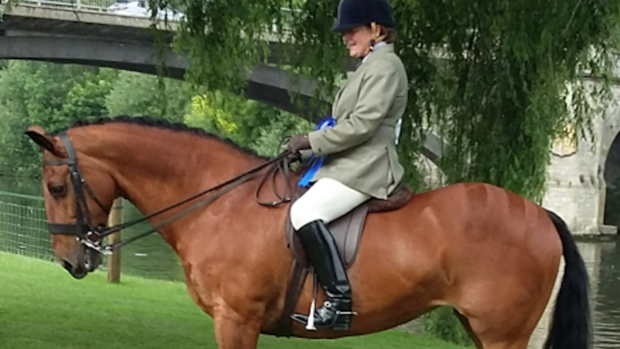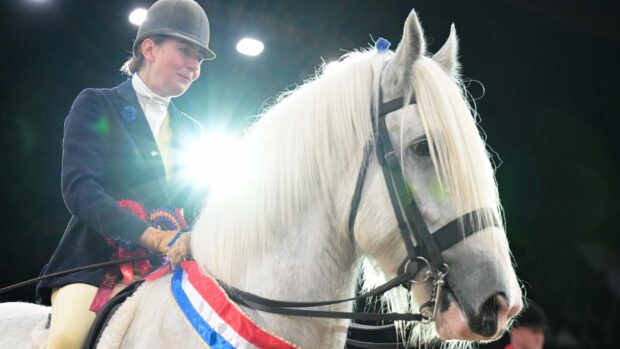The Cleveland Bay horse is said to be England’s oldest horse breed, which has adapted through the ages to become the versatile breed we know today. Whether the fashion of the day was ploughing fields on the farm, pulling coaches of the nobility or the family cart, to being successful in the current sporting disciplines, the Cleveland Bay has retained its traditional quality while transforming to fit the requirements of each era.
In this article: History | Royal connection | Conformation | Temperament
History
Although the official history of the Cleveland Bay dates from 1884, when the Cleveland Bay Horse Society was founded, the breed’s roots go back centuries.
The breed’s name comes from where the horse is believed to have originated, the Cleveland Hills in Yorkshire, in the north-east of England – combined with the horse’s colour.
Back in mediaeval times in Yorkshire, there were clean-legged bays used for both riding and as pack horses. As they transported goods of the travelling salesmen, who were known in those times as “chapmen”, these horses were initially called Chapman horses. Their role developed over the years to become the horse of choice for pulling coaches when these became mainstream, thanks to their strength, endurance and quality. This was a tough and versatile horse, as adept at working in the fields as pulling a carriage.
As the standard in roads developed, a faster horse was required and so hot-blooded stallions descended from the early thoroughbreds, Barbs and Arabs were used on Cleveland mares, which added fineness and speed to this traditional breed. In turn, warmbloods such as the Oldenburg have used Cleveland Bay stallions to improve their bloodlines. Nowadays they are often crossed with thoroughbred bloodlines to produce sport horses.
Naturally, as the era of the coach horse dwindled and railways developed in the 19th century, the Cleveland Bay became more and more redundant. The Cleveland Bay Horse Society was formed in 1884 to preserve and promote the breed which has throughout the past 150 years been to various degrees at risk of extinction.
A helping royal hand
While the 1880s signalled trouble for the future of the Cleveland Bay in the UK, the breed was establishing itself in the US, which imported thousands of these horses. Across the pond, coaching was becoming increasingly popular as a pastime, and this outstanding coach horse was in hot demand. However, its popularity was short-lived and began to decline. To make matters worse, back in Europe thousands were being killed in the world wars on the battlefields, where they were a great asset pulling the artillery.
At the end of World War II, there were only a handful of stallions in England, and few mares. Soon after this, in the early 60s, The Queen stepped in. Her grandfather George V had been a Cleveland Bay breeder and when one of the rare Cleveland Bay colts, a horse named Mulgrave Supreme, was set to be exported, The Queen bought him. Mulgrave Supreme was made available at public stud, and this marked a resurgence in Cleveland Bay breeding, with his progeny proving competitive across the disciplines.

The Cleveland Bay/thoroughbred part-bred can make a good sports horse
The Queen continues to work to promote the breed, and uses them in her own carriage-breeding programme. She is also patron of the Cleveland Bay Horse Society.
The popularity of the breed has continued to ebb and flow with numbers of breeding stallions dropping to critical levels at various points in its history. However, thanks to the efforts of the Cleveland Bay Horse Society and its breeding programmes, the Cleveland Bay has survived. Yet it is still at risk – along with 11 other of Britain’s 14 native breeds.
Nowadays, this British breed is popular all over the world, especially in Australian and the US. In Pakistan, Cleveland Bays are the only breed of horse used to pull state carriages and are also used in government work.
Conformation of the Cleveland Bay
This is a medium-sized semi-draft horse, similar in build to a warmblood, with clean legs and no feather. They look like a quality, substantial hunter showing dignity and strength.
Height: 16hh–16.2hh
Colour: they are traditionally bay with black points, and the only white marking permitted is a small white star. However, since 2005 horses outside this breed standard can still be registered to protect their genetic value to the breed, but this will be noted in their passport/studbook. Legs that are not black to the knee and hocks are regarded as a colour fault
Body: wide and deep, with a compact and strong back. Sloping, muscular shoulders; level and powerful quarters
Head: bold and of a decent size rather than fine; carried on a long, lean neck, with large, fine ears
Limbs: nine inches-plus bone below the knee. Legs should be clear of superfluous hair and clean and hard. Muscular upper legs, with large knees and hocks
Feet: a significant feature of the breeds, should be excellent quality and blue in colour – never shallow or narrow
Action: free, good-moving horse with sufficient shoulder and knee/hock flexion. High action is not characteristic – they should cover the ground

The Cleveland Bay characteristically is bay with very little no white, and black points above the knee and hock
Temperament
The Cleveland Bay is typically a docile, sensible character with a placid temperament. They tend to be well-disciplined, mannerly and easy to train – but as all horse owners know, every horse is an individual and how they turn out is down to many influences, from breeding to training, genetics and character.
Its hallmark is its versatility – it can turn its hoof to all disciplines, as it has shown through its need to adapt through the ages to the changing face of civilisation.
You may also be interested to read…

Queen’s stamp of approval for Cleveland bay mares
The two mares are heading to the Royal Paddocks for a breeding programme

The Clydesdale horse: the pride of Scotland with both substance and style

The ‘do-all draft horse’: a snapshot of the versatile Percheron

The Morgan horse: the loyal, versatile and distinctive American all-rounder
With its unusual stance, high head carriage and long flowing tail, the Morgan horse is known as the ultimate all-rounder

Subscribe to Horse & Hound magazine today – and enjoy unlimited website access all year round
Horse & Hound magazine, out every Thursday, is packed with all the latest news and reports, as well as interviews, specials, nostalgia, vet and training advice. Find how you can enjoy the magazine delivered to your door every week, plus options to upgrade your subscription to access our online service that brings you breaking news and reports as well as other benefits.




